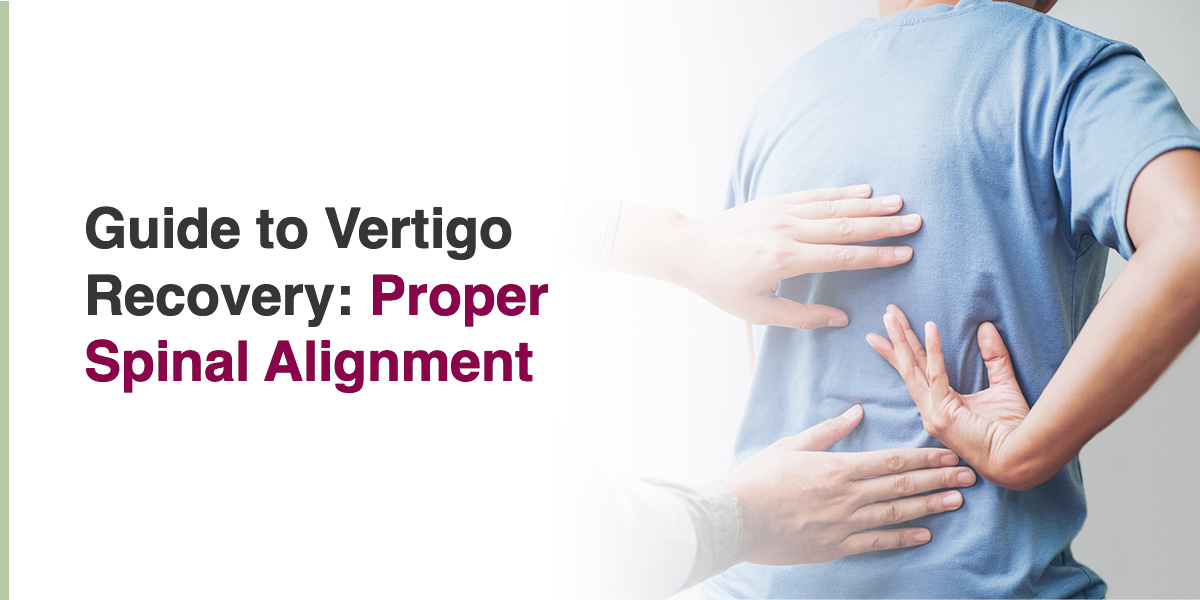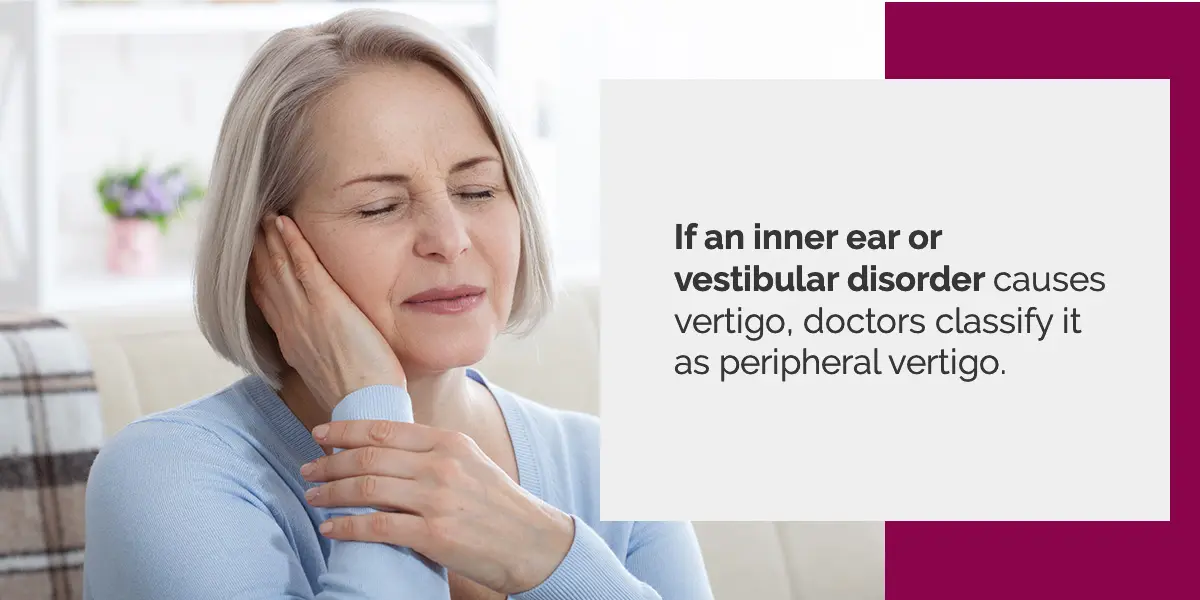Guide to Vertigo Recovery: Proper Spinal Alignment

One tip for vertigo recovery may surprise you — proper spinal alignment. Although vertigo involves issues with the ear and brain, your spine health plays a crucial role in vertigo recovery. So, how can proper spinal alignment help in vertigo relief? We’ll explain the link between cervical spinal alignment and vertigo, as well as tips for vertigo recovery, in this article. First, let’s go over some vertigo basics before showing how to recover from vertigo.
Table of Contents
What Is Vertigo?
Vertigo goes beyond feeling dizzy — it is a condition where individuals feel like they and their surroundings are spinning or off balance. Due to this disorientation, dizziness is a common symptom of vertigo. It may also accompany other symptoms, such as nausea, vomiting, sweating and walking problems.
Causes of Vertigo
Vertigo mainly originates from issues within the inner ear or brainstem. The vestibular nerves in your inner ear send signals to your brainstem that help you maintain your balance and navigate gravity’s force. The vestibular nerves, along with a labyrinth of semicircular canals and a vestibule, make up the vestibular system. When you experience inner ear issues, it can impact these vestibular signals. Vertigo commonly occurs when inner ear or brainstem issues disrupt these signals.
In this way, vertigo is often a symptom of underlying issues. Here are some underlying causes of vertigo:
- BPPV: With BPPV, tiny calcium crystals dislodge from their original location within the vestibular system and move into the ear canal. If BPPV causes vertigo, you’ll notice symptoms when moving your head in certain positions.
- Brain injury: Many individuals who experience a traumatic brain injury (TBI) have vertigo as a symptom. Vertigo may occur with a brain injury if the trauma damages your vestibular system, visual cortex or brainstem — the areas of your brain that control movement.
- Brain tumors: While uncommon, brain tumors can cause vertigo if the tumor affects the vestibular system, visual cortex or brainstem.
- Chemical exposure: Various toxic chemicals, such as paint, solvent, petroleum and glue products, can cause vestibular disorders, leading to vertigo.
- Head and neck trauma: Individuals who experience blunt trauma to, or have other problems at, the head and neck junction commonly experience vertigo, as the brainstem is located at this junction. Even a pinched nerve here could cause vertigo. Cervical misalignment may also cause problems with this junction.
- Labyrinthitis: This condition occurs when your vestibular system’s semicircular canals swell and become irritated, often causing vertigo.
- Meniere’s disease: This inner ear disorder occurs when fluid buildup changes the pressure inside the vestibular system, causing vertigo, tinnitus and hearing loss.
- Multiple sclerosis (MS): This neurological condition disrupts nerve signals between the brain and spinal cord. If MS causes a lesion near the brainstem, which often happens, vertigo commonly occurs.
- Stroke: Vertigo is an atypical symptom of stroke, which occurs due to disrupted or excess blood flow to the brain.
- Vestibular migraines: Patients with migraine history who start experiencing dizziness and vertigo are diagnosed with vestibular migraines. This condition is also called migraine-associated vertigo.
- Vestibular neuritis: This inner ear condition occurs when the nerves that send balance signals to the brain experience inflammation. The nerve inflammation causes vertigo.
The Two Types of Vertigo
Vertigo has two types — peripheral and central. These vertigo types are categorized according to their causes.
Peripheral Vertigo

If an inner ear or vestibular disorder causes vertigo, doctors classify it as peripheral vertigo. The most common cause of peripheral vertigo is BPPV, which accounts for over half of all reported cases. Other conditions that cause peripheral vertigo include:
- Labyrinthitis.
- Meniere’s disease.
- Vestibular neuritis.
Inflammation caused by influenza, cold or bacterial infections also falls under this category, as do physical trauma and motion sickness.
Here are some peripheral vertigo symptoms:
- Dizziness
- Ear pain
- Feeling of fullness
- Hearing loss
- Mild to moderate balance problems
- Nausea
- Tinnitus, or ringing in the ear
- Vomiting
- Weakness on one side of the face that improves after a few days
Central Vertigo
In contrast, central vertigo occurs when an injury to the balance centers of the central nervous system causes vertigo symptoms. Such injuries often involve a lesion in the cerebellum or brainstem. Compared to peripheral vertigo, central vertigo is linked with less prominent dizziness and nausea. Here are some conditions that cause central vertigo:
- Brain tumors.
- Cerebral dysfunction.
- Cervical spine disorders, such as cervical spondylosis.
- Chemical exposures.
- Degenerative ataxia disorders.
- Epilepsy.
- Lesions.
- Multiple sclerosis (MS).
- Parkinson’s disease.
- Stroke.
- Traumatic brain injuries (TBIs).
- Vestibular migraines.
Central vertigo symptoms include:
- Abnormal eye movements and other neurological inconsistencies.
- Double vision.
- Severe balance issues, to the point that you find it is impossible to walk or stand.
- Slurred speech.
How the Cervical Spine Is Linked to Vertigo
The cervical spine has seven vertebrae. The top two bones are the atlas and axis, also called C1 and C2. The C1 and C2 are critical to your head’s mobility. The C1 supports the skull and connects it to the C2. About 50% of the neck’s flexibility and rotation happens here, while the other 50% occurs between C1 and C2.
The neck consists of muscles, nerves, tendons, ligaments and bones. The C1 and C2 shelter the brainstem and spinal cord. The brainstem relays messages to the brain to regulate every attribute of the body while providing flexibility and strength. If the brainstem suffers damage and malfunctions, or if the vertebrae are misaligned, vertigo and dizziness can occur.
The cervical spine has three critical jobs:
- Holds and protects the spinal cord: Your spinal cord is a bundle of nerves from the brain that goes through the cervical spine and contains the brainstem.
- Enables blood flow to the brain: Vertebral arteries pass through openings in the cervical spine and provide blood flow to the brain.
- Supports the head and allows for movement: The cervical spine supports your head, which can be as heavy as 13 pounds, and helps it move in different directions.
With such an important role, any damage, malfunction or misalignment to C1 and C2 can have widespread effects. So, what are the symptoms of the misaligned C1 and C2 vertebrae?
The Righting Reflex and Its Connection to Vertigo
If either C1 or C2 becomes misaligned, the head tilts slightly to one side, triggering your body’s righting reflex. The righting reflex keeps your eyes level with the horizon line. However, the righting reflex could negatively impact the fluid-filled semicircular canals in your ear if it pressures your brainstem. When the misaligned vertebrae pressure your brainstem, it can cause inaccurate signals to pass from your brainstem to your ear, so this vertigo is caused by spinal issues. The inaccurate signals can cause a spinning sensation. In such situations, aligning your upper cervical spine can resolve vertigo symptoms.
Upper Cervical Chiropractic Care Corrects Vertigo
A notable case study shows how upper cervical chiropractic care became an excellent source of vertigo relief. A 23-year-old woman had suffered from headaches her entire life. She sustained a hard fall that resulted in a concussion. She eventually displayed post-concussion syndrome symptoms, including worsening headaches and vertigo. X-rays showed that her entire body was imbalanced from upper cervical spine misalignment. After her first adjustment from an upper cervical chiropractor, she reported significant improvements, including vertigo and headache relief!
Here at Upper Cervical of Monmouth in Morganville, New Jersey, we provide spinal alignment for vertigo relief. We don’t force, pop or crack the spine. Instead, we perform gentle, accurate adjustments that provide long-term results, including C1 and C2 misalignment solutions! Nearly all our patients report relief and complete recovery from their vertigo symptoms. If you’re seeking vertigo care from a trustworthy chiropractor in New Jersey, consider Upper Cervical of Monmouth. Visit our clinic or schedule a consultation with us today!





